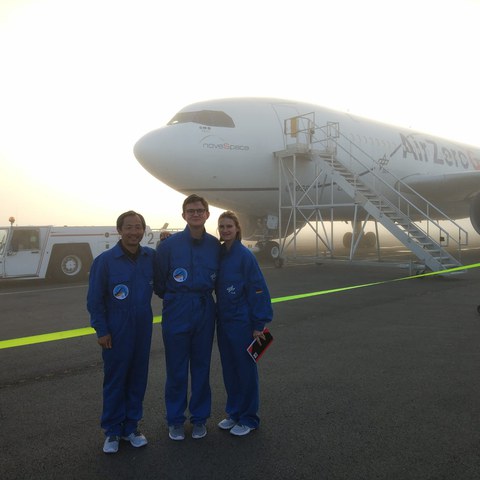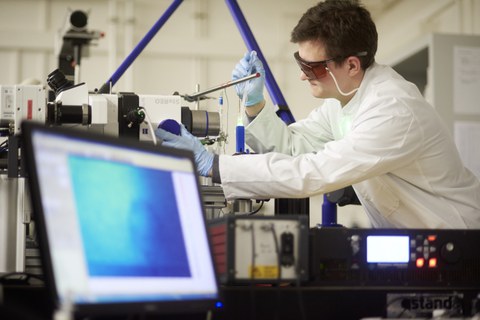Nov 09, 2020
TU Dresden and HZDR scientists win the Innovation Award of the German Gas Industry
Joint press release of TU Dresden and Helmholtz-Zentrum Dresden-Rossendorf (HZDR)
Parabolic flights in the name of hydrogen research
A team from the Helmholtz-Zentrum Dresden-Rossendorf (HZDR) and Technische Universität Dresden led by Prof. Kerstin Eckert and Dr. Gerd Mutschke has won the German Gas Industry Innovation Award 2020 in the Research and Development category. The award ceremony took place on November 4 in Berlin. The Innovation Prize is awarded every two years for ground-breaking energy concepts. It is awarded to projects that address climate protection and resource conservation in a game-changing way and thus make a crucial contribution to the energy revolution.

Dr. Xuegeng Yang, M.Sc. Aleksandr Bashkatov, Dipl.-Ing. Barbara Fritzsche (v.l.).
In the award-winning project "Research to improve the efficiency of water electrolysis by investigating the influence of electrical and thermocapillary forces on the detachment of hydrogen bubbles", the scientists from the HZDR Institute of Fluid Dynamics and the Institute of Process Engineering and Environmental Technology at TU Dresden have gained significant insights into how different forces act on the gas bubbles that form on the electrodes.
Since the persistence of gas bubbles on the electrodes in the alkaline electrolyzer leads to both electrical and heat losses, therefore influencing the efficiency of the entire process, a better understanding of this balance of forces is vital in order to optimize the electrolysis processes. "At present, hydrogen produced by electrolysis is more expensive than hydrogen produced from natural gas," says Dr. Gerd Mutschke. "With our research, we are seeking to make a contribution to being able to produce electrolysis hydrogen in a more cost-effective way".
During the experiments, the researchers observed that individual bubbles detach from an electrode up to a hundred times per second, only to return to it instantly. They assume that an electrical force, not previously considered, competes with the buoyancy force and makes these oscillations possible. They also discovered that Marangoni currents caused by temperature differences exert forces on the bubbles. Based on this knowledge, the scientists now want to improve the design of the electrolyzers by reducing the retention time of the gas bubbles on the electrodes. This allows a higher hydrogen production rate with improved electrolyzer efficiency.
According to Prof. Kerstin Eckert, these findings have been made possible primarily by the combination of the versatile measuring techniques with the theoretical-numerical work at the HZDR and the TU Dresden Institute for Process Engineering and Environmental Technology. The Professor of Transport Processes at Interfaces at TU Dresden also emphasizes the parabolic flights in a converted Airbus sponsored by the German Aerospace Center (DLR) as an extraordinary research environment. "During these flights, where weightlessness is achieved for short periods of time through special flight maneuvers, the buoyancy is selectively switched off. We were thus able to investigate phenomena of the bubbles in an isolated form, i.e. in the pure form. Mutschke also underlines the relevance of parabolic flights for these experiments. "The alternating conditions of weightlessness and hypergravity create entirely modified bubble dynamics. For instance, the gas bubbles adhere much longer to the electrodes under the conditions of weightlessness. This enables a more precise measurement of the Marangoni flow".
The HZDR and TU Dresden are currently planning to investigate the new concept of membrane-free alkaline electrolyzers in a joint project with partners from the Fraunhofer Institute for Manufacturing Technology and Advanced Materials Dresden (IFAM), the University of Applied Sciences Zittau-Görlitz and local industrial partners. The aim is to develop an experimental platform for fundamental research, including water and oxygen formation and electrode degradation at high current densities, in order to investigate various electrode materials and electrolyzer designs for their suitability for the cost-efficient supply of green hydrogen.
Helmholtz-Zentrum Dresden-Rossendorf at a glance
The Helmholtz-Zentrum Dresden-Rossendorf conducts research in the fields of energy, health and matter. The research is focused on the following questions:
- How do you use energy and resources efficiently, safely and sustainably?
- How can cancer diseases be better visualized, characterized and effectively treated?
- How do matter and materials behave under the influence of high fields and in the smallest dimensions?
The HZDR develops and operates large infrastructures that are also used by extramural guests: Ion Beam Center, High Magnetic Field Laboratory Dresden and ELBE Center for High Power Beam Sources.
HZDR is a member of the Helmholtz Association, has six locations (Dresden, Freiberg, Görlitz, Grenoble, Leipzig, Schenefeld near Hamburg) and employs almost 1,400 staff including 500 scientists and 170 PhD students.
TU Dresden at a glance
TU Dresden is one of the top universities in Germany and Europe: strong in research, first-class in the variety and quality of its courses, closely connected to culture, business and society. As a modern university, with its five Schools in 18 faculties, it offers a broad academic spectrum like few other universities in Germany. It is the largest university in Saxony. The large TU Dresden campus family consists of around 32,000 students and about 8,000 employees – including 600 professors. Since 2012, TU Dresden has been one of the eleven Universities of Excellence in Germany. On July 19, 2019, it successfully defended this title.
Media inquiries
Prof Kerstin Eckert
Chair of Transport Processes at Interfaces TU Dresden
+49 351 463 - 36551
Prof Kerstin Eckert
Chair of Transport Processes at Interfaces
Institute of Fluid Dynamics
Helmholtz-Zentrum Dresden-Rossendorf
+49 351 260 3860
Dr Gerd Mutschke
Institute of Fluid Dynamics
Helmholtz-Zentrum Dresden-Rossendorf
+49 351 260 2480

